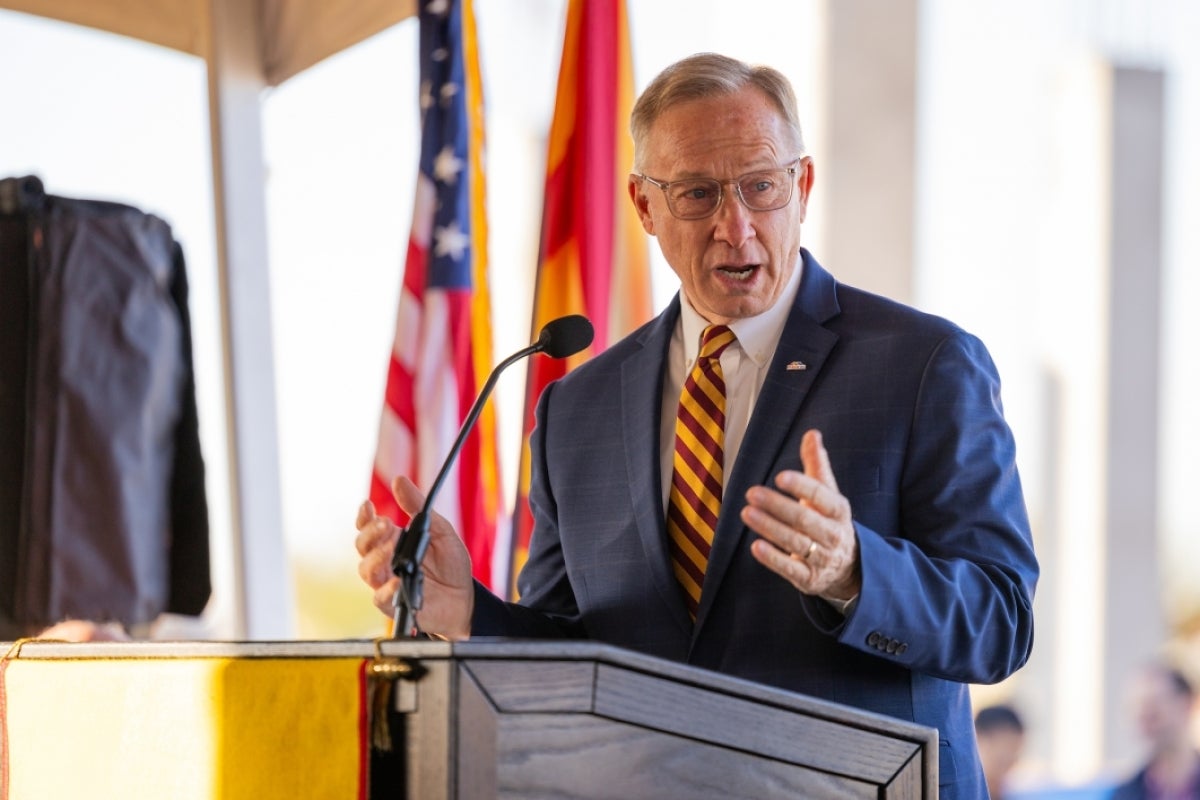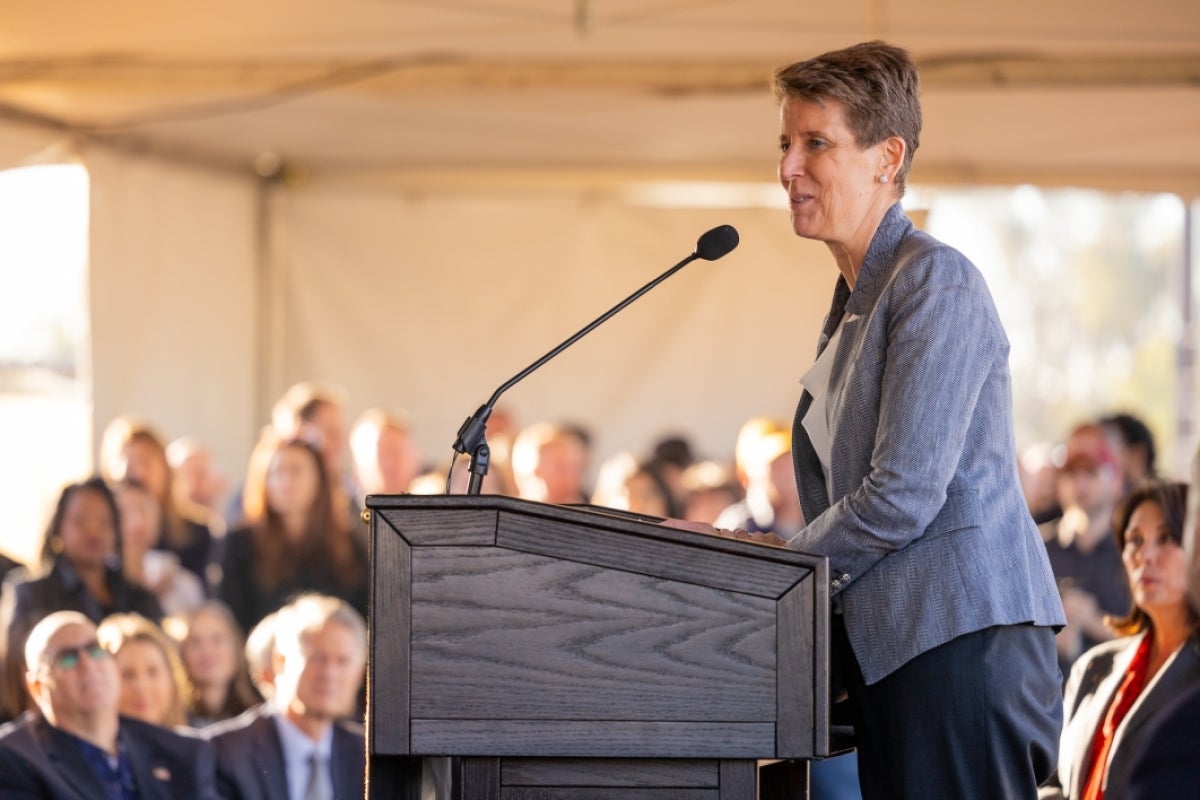ISTB12 to be major economic boost in region

ISTB12, now under construction, will be the largest building on the Polytechnic campus when it's done in fall 2025 and will be home to the new School of Manufacturing Systems and Networks. Photo by Samantha Chow/ASU News
Editor’s note: This story is featured in the 2023 year in review.
Arizona State University’s new building on the Polytechnic campus will be a catalyst to not only grow student enrollment and but also to drive economic development in the region.
Many elected officials, ASU leaders and community members gathered on Tuesday to celebrate the 12th Interdisciplinary Science and Technology Building, now under construction, in a ceremonial groundbreaking.
ISTB12, expected to be open by fall 2025, will have three floors of high-tech labs, classrooms, makerspaces and meeting spaces, and be home to the new School of Manufacturing Systems and Networks in the Ira A. Fulton Schools of Engineering.
ASU spent $185 million constructing ISTB12, and when the cutting-edge equipment is installed, the project will be a $250 million investment in the region, according to Morgan Olsen, executive vice president, treasurer and chief financial officer of ASU.
“This building is focused on the manufacturing industry in a variety of manifestations,” he said.
“The connections with industry will be many and deep. The goal is to prepare professionals who will contribute engineering solutions for societal challenges.”
Located on the southwest corner of the campus, the building is adjacent to the ASU Polytechnic Innovation Zone, a partnership with the city of Mesa. The city is set to help ASU launch the Innovation Zone with infrastructure support. The expectation for the nearly 130 acres of developable land is more than 500 jobs and over $800 million in economic impact.
Mesa Mayor John Giles told the groundbreaking crowd that the major high-tech corporations in Mesa have repeatedly emphasized to him the need for workforce development.
“I hear, ‘If we come to your community and invest billions of dollars, will you have the talent to walk into those buildings and make them function the way they need to?’
“This partnership with ASU and this building are exactly what this region needs to respond to the challenge we have. This is where the talented people who will justify the investment in the area will come from.”
ISTB12 is the embodiment of the realization that America needs to reclaim its role in manufacturing, according to ASU President Michael Crow.
“Here in the United States, we’re beginning to decide that we’d like to have a really successful country that can’t be threatened by someone taking technology away from us, where we can build from what our geniuses can develop,” he said.
“We’re advancing new solutions, new ideas, new technologies, new ways of solving things, new ways of making things, new ways of making our country better — better protected, more economically successful, more socially just.
“If you don’t have jobs for people, there’s no social justice.”
Crow said that ASU is building the most advanced manufacturing school ever.
“We’re going to be able to build anything at any scale, from the tiniest atom up to an integrated system,” he said.
Binil Starly, director of the School of Manufacturing Systems and Networks, said that the first floor of ISTB12 will house labs dedicated to manufacturing research and have large machines for manufacturing, robotics and autonomous cars.
“The walls will have glass so people can see what’s happening inside,” he said.
“It will be a showcase of what manufacturing is.”
The second floor will include classrooms and teaching labs, including labs for robotics, semiconductors and additive manufacturing.
The third floor will be flexible space.
“It will allow industry partners to come in and partner with faculty and set up collaborative spaces that can showcase projects with students,” he said.
The building’s proximity to the Innovation Zone will allow industry to be embedded in the academic experience, according to Nancy Gonzales, executive vice president and university provost.
“This is the use-inspired research that we’ve become known for nationally and internationally come to life on the Polytechnic campus,” she said on Tuesday.
With its many classrooms, ISTB12 will serve students in all majors, she said.
“As is always the case, ASU has big goals, and one goal is we plan to grow enrollment on the Polytechnic campus to 15,000 by the fall of 2028. It’s an aggressive but attainable increase from about 6,000 students currently,” she said, adding that ISTB12 will be a big draw for students.
With a focus on collaboration, education and research, the building will be more than a physical place, according to Sally Morton, executive vice president of ASU’s Knowledge Enterprise, the research and economic development ecosystem.
“It will serve as a physical catalyst for intellectual interactions. It will be a generator of ideas, energy and solutions for society’s greatest challenges,” she said.
“And we will do so in concert with our partners, as well as, most importantly, our students.”
More Science and technology

Stuck at the airport and we love it #not
Airports don’t bring out the best in people.Ten years ago, Ashwin Rajadesingan was traveling and had that thought. Today, he is an assistant professor at the University of Texas at Austin, but back…

ASU in position to accelerate collaboration between space, semiconductor industries
More than 200 academic, business and government leaders in the space industry converged in Tempe March 19–20 for the third annual Arizona Space Summit, a statewide effort designed to elevate…

A spectacular celestial event: Nova explosion in Northern Crown constellation expected within 18 months
Within the next year to 18 months, stargazers around the world will witness a dazzling celestial event as a “new” star appears in the constellation Corona Borealis, also known as the Northern Crown.…




